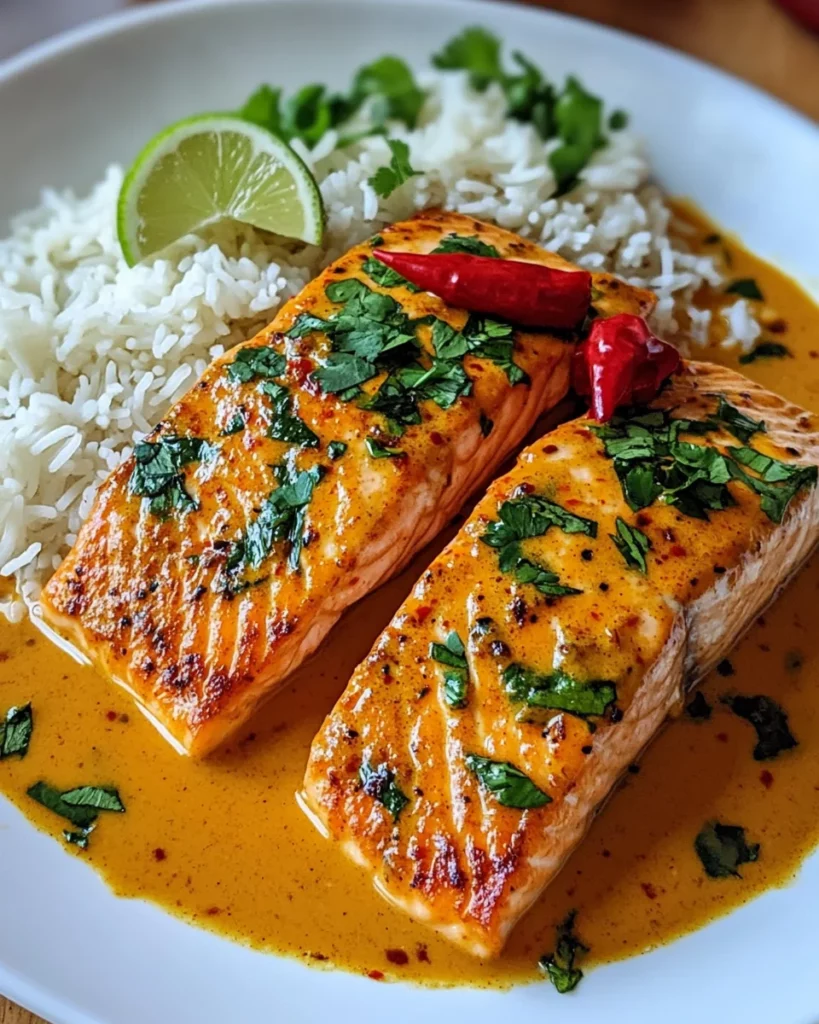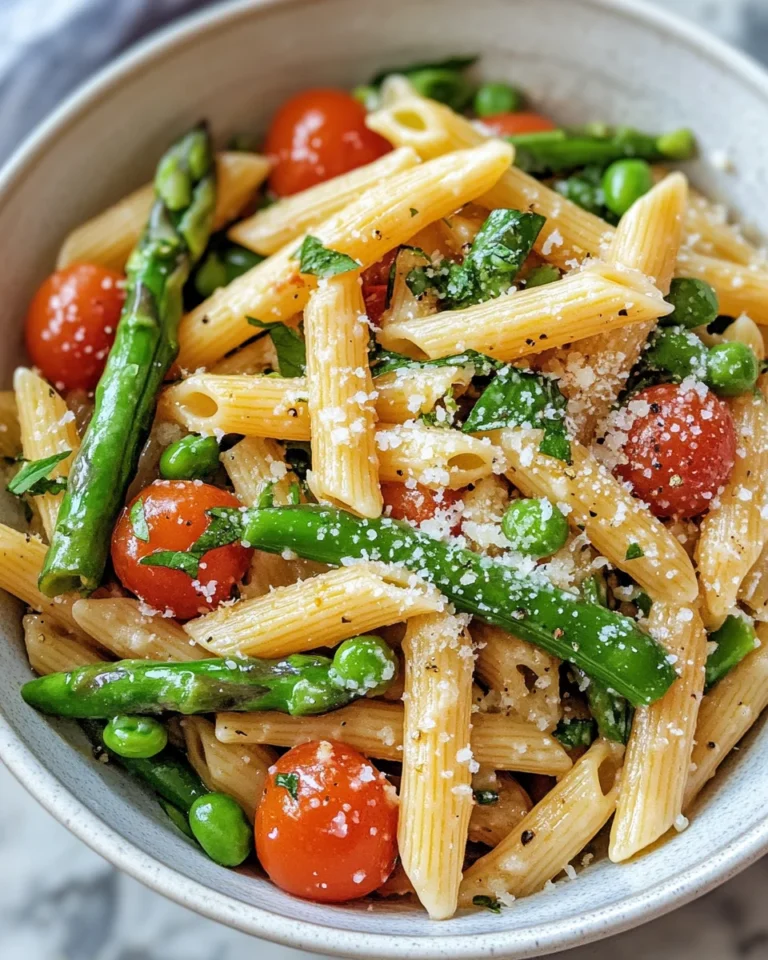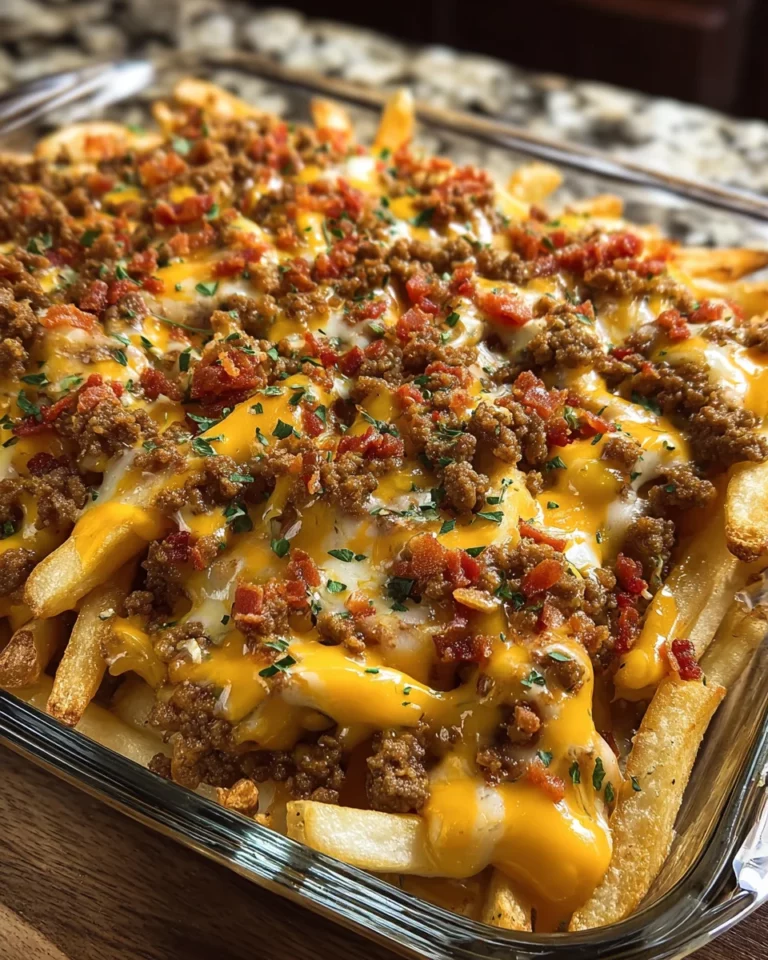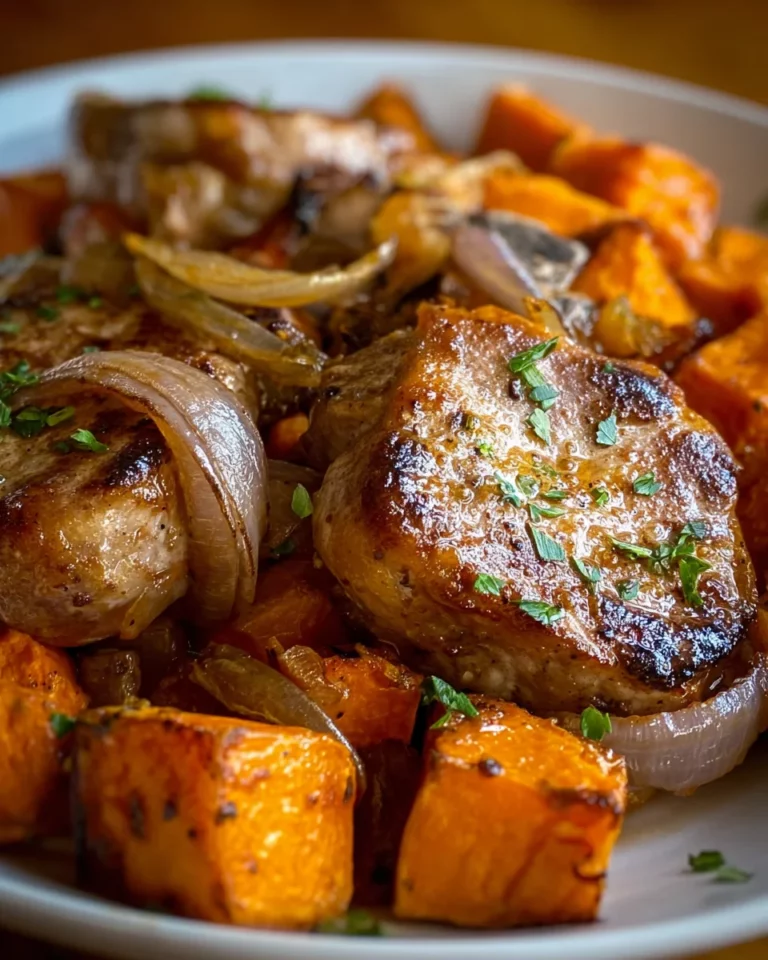Coconut Curry Salmon: A Flavor Explosion Awaiting You!
Introduction to Coconut Curry Salmon
Let me tell you about one of my favorite go-to dishes: Coconut Curry Salmon. If you’re a busy mom juggling work, kids, and everything in between, this meal is your culinary lifesaver! It’s quick to make, but bursting with flavors that will make you feel like a master chef. Plus, it’s a fantastic way to sneak in some healthy salmon while keeping your loved ones happy. The creamy coconut curry sauce dances on your taste buds, and trust me, it’s a dish that impresses without the stress. Ready to dive into this flavor explosion? Let’s get cooking!
Why You’ll Love This Coconut Curry Salmon
You’re going to fall in love with this Coconut Curry Salmon for so many reasons! First off, it’s on the table in just 45 minutes, perfect for those hectic weeknights. The taste? Oh, it’s a flavor fiesta! The creamy coconut sauce combined with the zesty kick of red curry is simply divine. Plus, it’s a one-pan meal, which means fewer dishes to clean—who doesn’t love that?
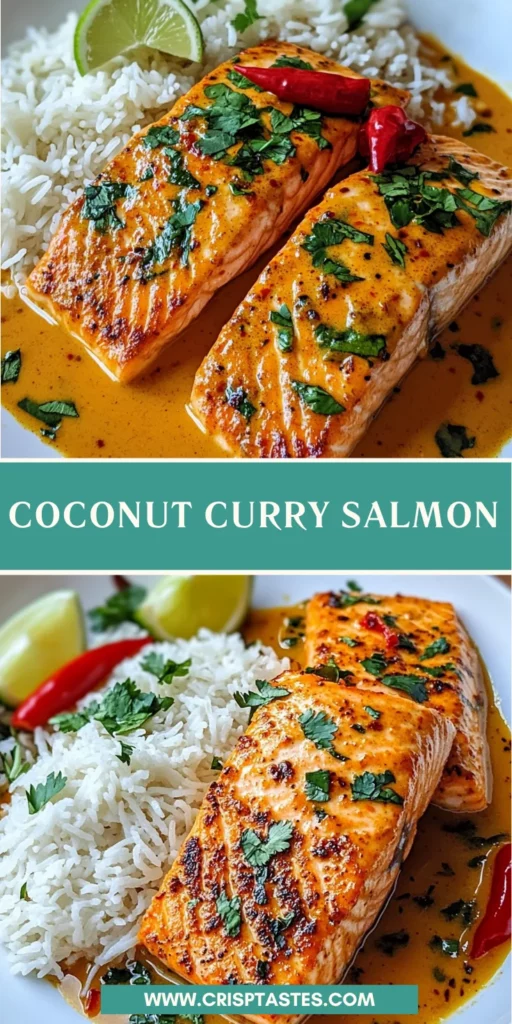
Ingredients for Coconut Curry Salmon
Gathering the right ingredients for Coconut Curry Salmon is half the fun! Here’s what you’ll need:
- Salmon fillets: Fresh or frozen, these are the star of the show. They’re rich in omega-3 fatty acids and protein, perfect for a health-conscious meal.
- Olive oil: A splash of this versatile oil helps in seasoning and searing the salmon perfectly.
- Sea salt and black pepper: Simple seasonings that enhance the natural flavors of the salmon.
- Garlic powder and paprika: These spices add depth and earthiness to each bite.
- Coconut oil: Adds a delightful coconut flavor to the sautéed veggies and helps in cooking them to perfection.
- Onion: Chopped onion infuses sweetness and aroma into the curry sauce.
- Garlic and ginger: Freshly minced garlic and grated ginger bring a zing while adding health benefits too!
- Red bell pepper: This sweet pepper adds color and crunch to the dish.
- Coconut milk: Full-fat coconut milk is creamy and luxurious, making the curry rich and satisfying.
- Red curry paste: Adjust the amount of this firework of flavor based on your desired spice level.
- Soy sauce (or tamari): This adds umami depth; tamari is a great gluten-free alternative.
- Lime juice: Freshly squeezed lime juice brightens up the sauce with a zesty finish.
- Brown sugar (or honey): A touch of sweetness balances the flavors beautifully.
- Vegetable or chicken broth: Use this for the desired consistency of the sauce without overwhelming it.
- Cilantro and basil: Fresh herbs bring a burst of freshness to the final dish.
- Optional red chili: Add sliced red chili if you crave that extra heat!
- Sides: Consider serving with rice (jasmine or basmati), quinoa, or even naan bread and a colorful assortment of steamed vegetables.
Exact quantities for everything can be found at the bottom of this article, perfectly printed for your convenience. Have fun as you put together these ingredients for your next culinary adventure!
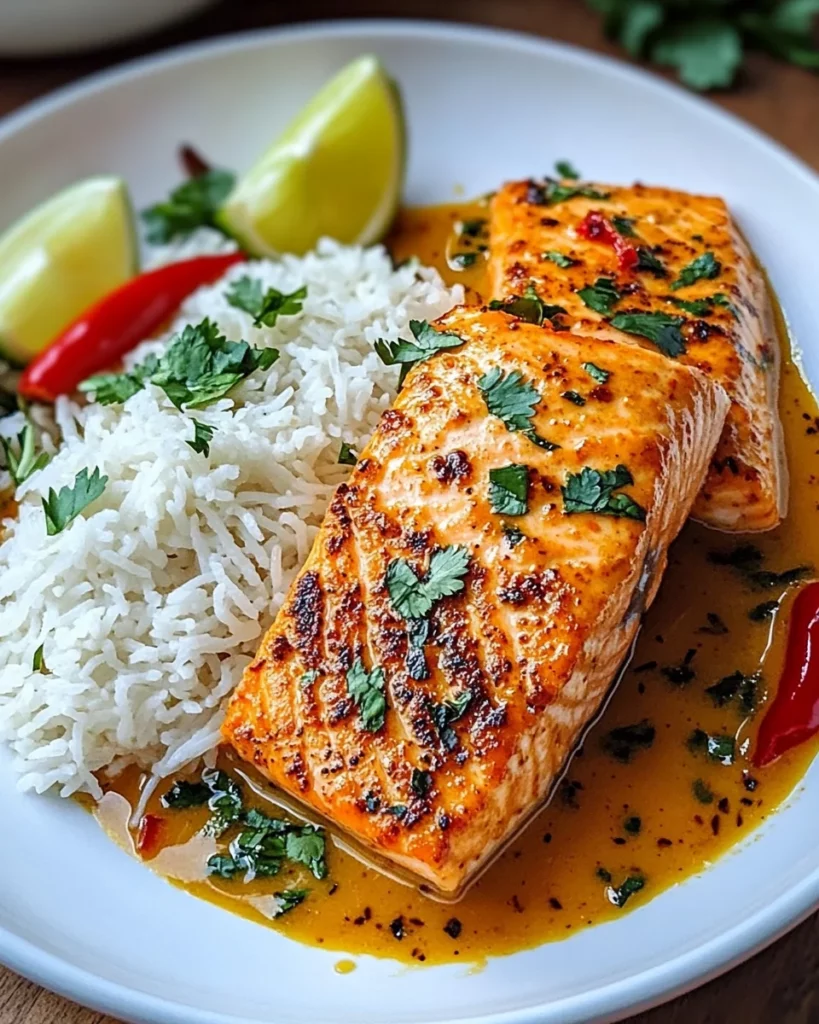
How to Make Coconut Curry Salmon
Ready to embark on a flavorful journey? Making Coconut Curry Salmon is just a few simple steps away. Get your apron on, and let’s dive into this culinary adventure!
Prepare the Salmon Fillets
First, take your salmon fillets and pat them dry with paper towels. This helps achieve that gorgeous sear later on!
Next, in a small bowl, mix together the sea salt, black pepper, garlic powder, and paprika.
Sprinkle this seasoning mix evenly on both sides of the salmon fillets.
Sauté the Aromatics
Now, it’s time to bring out the flavors!
Heat a tablespoon of coconut oil in a large skillet over medium heat. As it warms up, add the chopped onion and stir. Cook until the onion softens, about 5-7 minutes.
Once the onion is nice and translucent, toss in the minced garlic and grated ginger. The moment these hit the pan, your kitchen will smell heavenly! Cook for another minute.
Then, add in the thinly sliced red bell pepper. Cook for 3-5 minutes until it slightly softens but still has that delightful crunch.
Create the Coconut Curry Sauce
Now for the creamy goodness!
Pour in the rich coconut milk, stirring gently as you go. Follow that with the red curry paste. Don’t be shy; whisk it all in until the paste is fully dissolved into the coconut milk.
Next, stir in the soy sauce, freshly squeezed lime juice, and brown sugar. This perfect combination balances the flavors beautifully.
Finally, pour in the vegetable or chicken broth and bring everything to a simmer. Let it bubble happily for 10-15 minutes, stirring occasionally. This allows all those lovely flavors to meld together, creating a fragrant curry sauce.
Cook the Salmon
While your sauce is simmering, let’s get that salmon sizzling!
In a different skillet, heat olive oil over medium-high heat. When it’s hot and shimmering, place the salmon fillets skin-side down (if using skin-on).
Sear them for 3-4 minutes until they turn crispy and golden brown. Then, carefully flip the fillets and sear them for another 1-2 minutes. You want them perfectly golden but not fully cooked.
Once done, gently transfer the salmon into the simmering coconut curry sauce. Make sure most of the fillets are submerged in that luscious sauce!
Cover the skillet, allowing the salmon to poach in the sauce for 5-7 minutes. When it’s ready, the fish should be opaque and flake easily with a fork.
Assemble and Serve
Carefully remove the salmon fillets from the skillet, placing them on plates.
Spoon that rich coconut curry sauce generously over each fillet. It’s like wrapping the salmon in a warm, flavorful hug!
Don’t forget to garnish with freshly chopped cilantro and basil. If you like a kick, sprinkle some thinly sliced red chili on top!
Serve immediately with your choice of cooked rice, quinoa, or naan bread, and enjoy a delightful meal that brings everyone to the table!
Tips for Success
- For a quicker prep, buy pre-chopped vegetables.
- Check the salmon for freshness by looking for a bright, moist color.
- Adjust the red curry paste gradually, tasting as you go to find your preferred spice level.
- If you have leftovers, store the curry sauce separately to keep the salmon fresh.
- Pairing with a side salad enhances the meal and adds freshness!
Equipment Needed
- Large skillet: A non-stick skillet works wonders for easy cooking.
- Medium skillet: Any frying pan will do for searing the salmon.
- Whisk: Essential for mixing the coconut milk and curry paste thoroughly.
- Measuring spoons: Slightly undercooking or measuring with precision adds value.
- Spatula: A flexible spatula helps flip and delicately move the salmon.
Variations for Coconut Curry Salmon
- Vegetable Option: Swap out salmon for chickpeas or tofu for a hearty plant-based meal.
- Different Proteins: Use shrimp or scallops for a different seafood twist—just adjust cooking times.
- Spice Level: Experiment with different curry pastes like green curry for varied flavor profiles.
- Herb Swap: Try using fresh mint instead of basil for a refreshing change.
- Coconut Milk Alternatives: Use light coconut milk or a mix of coconut milk and Greek yogurt for a lower-fat version.
Serving Suggestions for Coconut Curry Salmon
- Pair the Coconut Curry Salmon with fluffy jasmine or basmati rice to soak up that delicious sauce.
- Quinoa is a great gluten-free option, adding a nutty flavor to the meal.
- Warm naan bread is perfect for dipping in the curry sauce.
- Serve with a side of steamed broccoli, green beans, or spinach for a healthy, colorful plate.
- A light, refreshing cucumber salad or a chilled glass of white wine can complement the curry beautifully!
FAQs about Coconut Curry Salmon
Can I use frozen salmon for this recipe?
Absolutely! Just make sure to thaw it completely before cooking.
How can I make this dish spicier?
If you crave heat, add more red curry paste or toss in some thinly sliced jalapeños or a red chili, like I mentioned earlier.
What can I substitute for coconut milk?
In a pinch, you can use unsweetened almond milk with a spoonful of coconut extract. It won’t be as creamy, but it’ll still taste great!
How do I store leftovers?
Store the Coconut Curry Salmon in an airtight container in the fridge for up to 3 days. For freshness, keep the sauce separate from the salmon.
Is this dish gluten-free?
Yes! Just ensure you use gluten-free soy sauce or tamari, and you’re good to go.
Final Thoughts
Cooking should be a journey filled with joy and a sprinkle of creativity, and that’s precisely what Coconut Curry Salmon delivers. It’s a dish that not only satisfies your family’s taste buds but also brings warmth and comfort to your kitchen. The rich, creamy sauce envelops each flaky salmon fillet, making every bite a celebration. Whether you serve it on a busy weeknight or during a special gathering, it transforms any dinner into an unforgettable experience. I can’t wait for you to make this dish—trust me, it will quickly become a beloved staple in your household!
Print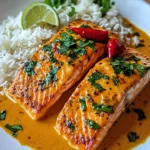
Coconut Curry Salmon
- Total Time: 45 minutes
- Yield: 4 servings 1x
- Diet: Gluten Free
Description
Coconut Curry Salmon: A delicious dish featuring salmon fillets cooked in a rich, creamy coconut curry sauce, bursting with flavor.
Ingredients
- 4 (6-ounce) salmon fillets, skin on or off
- 1 tablespoon olive oil
- 1 teaspoon sea salt
- ½ teaspoon black pepper
- ½ teaspoon garlic powder
- ¼ teaspoon paprika
- 1 tablespoon coconut oil
- 1 medium yellow onion, chopped
- 2 cloves garlic, minced
- 1 inch ginger, grated
- 1 red bell pepper, thinly sliced
- 1 (13.5-ounce) can full-fat coconut milk
- 2 tablespoons red curry paste (adjust to taste)
- 1 tablespoon soy sauce (or tamari)
- 1 tablespoon lime juice, freshly squeezed
- 1 teaspoon brown sugar (or honey)
- ½ cup vegetable broth (or chicken broth)
- ¼ cup chopped fresh cilantro, for garnish
- ¼ cup chopped fresh basil, for garnish
- Optional: 1 red chili, thinly sliced, for extra heat
- Cooked rice (jasmine or basmati)
- Quinoa
- Naan bread
- Steamed vegetables (broccoli, green beans, spinach)
Instructions
- Pat the salmon fillets dry with paper towels.
- Combine sea salt, black pepper, garlic powder, and paprika. Sprinkle evenly over both sides of the salmon fillets.
- Heat coconut oil in a large skillet over medium heat. Add chopped onion and cook until softened, about 5-7 minutes.
- Add minced garlic and grated ginger and cook for another minute, until fragrant.
- Add thinly sliced red bell pepper and cook for 3-5 minutes, until slightly softened.
- Pour in coconut milk and stir in red curry paste. Whisk well to dissolve.
- Stir in soy sauce (or tamari), lime juice, and brown sugar (or honey).
- Pour in vegetable broth (or chicken broth) and bring to a simmer. Reduce heat and simmer for 10-15 minutes, stirring occasionally, to allow the flavors to meld together.
- Taste and adjust seasoning as needed.
- Heat olive oil in a separate skillet over medium-high heat. Sear salmon fillets skin-side down (if using skin-on fillets) for 3-4 minutes, until crispy and golden brown. Flip and sear for another 1-2 minutes. Remove from skillet and set aside.
- Gently place the seasoned (and seared, if you chose to sear them) salmon fillets into the simmering coconut curry sauce. Make sure the fillets are mostly submerged in the sauce.
- Cover the skillet and let the salmon poach in the sauce for 5-7 minutes, or until the salmon is cooked through and flakes easily with a fork.
- Insert a fork into the thickest part of the fillet and gently twist. If the salmon flakes easily, it is cooked through. The internal temperature should reach 145°F (63°C).
- Carefully remove the salmon fillets from the skillet and place them on plates.
- Spoon the coconut curry sauce generously over the salmon fillets.
- Garnish with chopped fresh cilantro and basil. If you like a little extra heat, sprinkle with thinly sliced red chili.
- Serve immediately with cooked rice, quinoa, or naan bread. Steamed vegetables also make a great side dish.
Notes
- Adjust the heat by varying the amount of red curry paste used.
- This dish pairs well with various side options, including rice, quinoa, or naan.
- For added nutrition, serve with steamed vegetables.
- Prep Time: 15 minutes
- Cook Time: 30 minutes
- Category: Main Course
- Method: Sautéing and Poaching
- Cuisine: Thai
Nutrition
- Serving Size: 1 salmon fillet with sauce
- Calories: 450
- Sugar: 5g
- Sodium: 800mg
- Fat: 30g
- Saturated Fat: 20g
- Unsaturated Fat: 10g
- Trans Fat: 0g
- Carbohydrates: 15g
- Fiber: 2g
- Protein: 30g
- Cholesterol: 80mg

